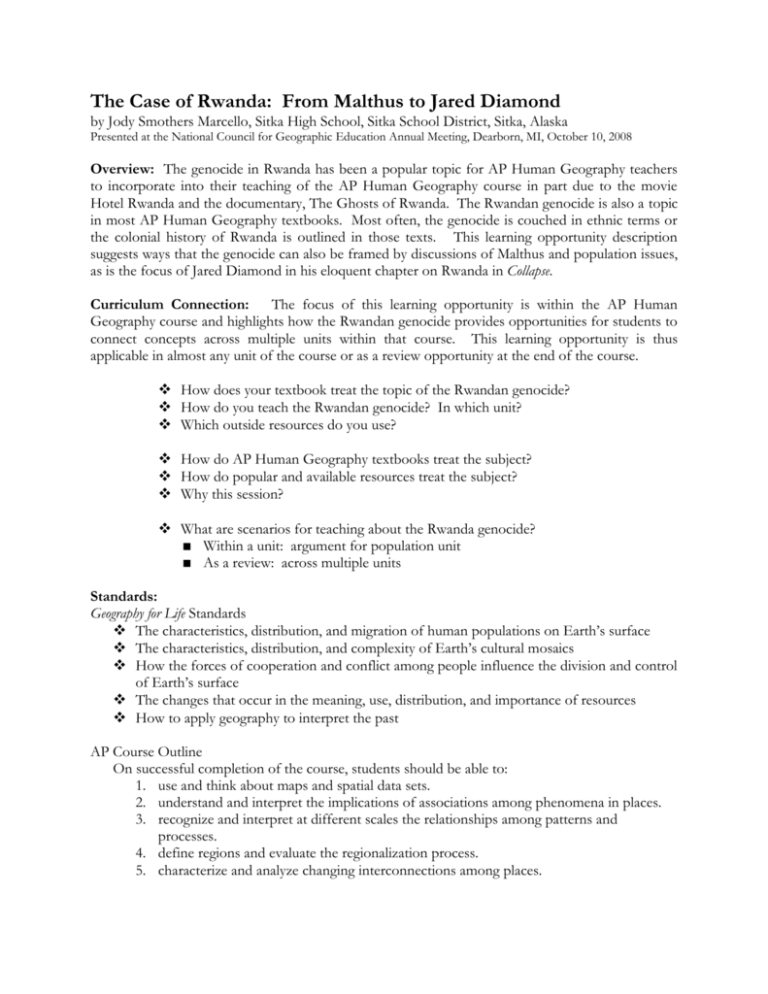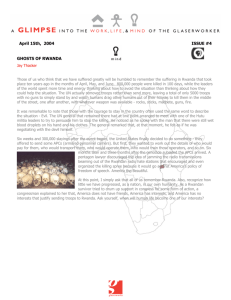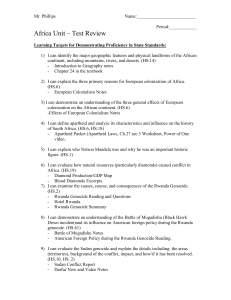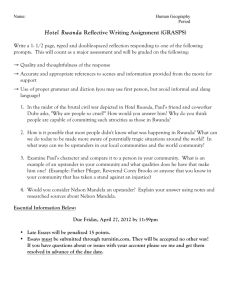
The Case of Rwanda: From Malthus to Jared Diamond
by Jody Smothers Marcello, Sitka High School, Sitka School District, Sitka, Alaska
Presented at the National Council for Geographic Education Annual Meeting, Dearborn, MI, October 10, 2008
Overview: The genocide in Rwanda has been a popular topic for AP Human Geography teachers
to incorporate into their teaching of the AP Human Geography course in part due to the movie
Hotel Rwanda and the documentary, The Ghosts of Rwanda. The Rwandan genocide is also a topic
in most AP Human Geography textbooks. Most often, the genocide is couched in ethnic terms or
the colonial history of Rwanda is outlined in those texts. This learning opportunity description
suggests ways that the genocide can also be framed by discussions of Malthus and population issues,
as is the focus of Jared Diamond in his eloquent chapter on Rwanda in Collapse.
Curriculum Connection:
The focus of this learning opportunity is within the AP Human
Geography course and highlights how the Rwandan genocide provides opportunities for students to
connect concepts across multiple units within that course. This learning opportunity is thus
applicable in almost any unit of the course or as a review opportunity at the end of the course.
How does your textbook treat the topic of the Rwandan genocide?
How do you teach the Rwandan genocide? In which unit?
Which outside resources do you use?
How do AP Human Geography textbooks treat the subject?
How do popular and available resources treat the subject?
Why this session?
What are scenarios for teaching about the Rwanda genocide?
Within a unit: argument for population unit
As a review: across multiple units
Standards:
Geography for Life Standards
The characteristics, distribution, and migration of human populations on Earth’s surface
The characteristics, distribution, and complexity of Earth’s cultural mosaics
How the forces of cooperation and conflict among people influence the division and control
of Earth’s surface
The changes that occur in the meaning, use, distribution, and importance of resources
How to apply geography to interpret the past
AP Course Outline
On successful completion of the course, students should be able to:
1. use and think about maps and spatial data sets.
2. understand and interpret the implications of associations among phenomena in places.
3. recognize and interpret at different scales the relationships among patterns and
processes.
4. define regions and evaluate the regionalization process.
5. characterize and analyze changing interconnections among places.
Essential Questions:
How is the Rwandan genocide a human geography case study that transcends multiple units
of the AP Human Geography course?
From what viewpoint is the Rwandan genocide best told: population dynamics, migration,
geopolitical, agricultural, or cultural?
Why Rwanda? Why this place? Why here? Why did the genocide occur here?
What is the variety of scales through which the Rwandan genocide must be viewed?
What are the demographics associated with Rwanda in the past and currently?
To what degree was/is Rwanda culturally diverse?
What has been the geopolitical history of Rwanda?
What is Rwanda’s current level of human development?
To what degree did/have the agricultural revolutions impact Rwanda?
What percent of Rwanda is urban and rural? Why?
To what degree does Jared Diamond’s five-point framework from Collapse fit the Rwandan
genocide story?
Vocabulary:
ethnicity
genocide
geopolitics
involuntary migration
refugees
imperialism
colonialism
democratic revolution
decolonization
Malthus
scale
pastoralists
agriculture
human development
collapse
Materials and Preparation:
Map of Rwanda
Collapse by Jared Diamond (or summary notes included here)
Ghosts of Rwanda or Hotel Rwanda
Malthus/Diamond comparison table
Student notetaking graphic organizer
Time Required:
Instruction:
Introducing the Learning Opportunity:
Developing the Learning Opportunity:
Spatial Perspective
Maps
Scales
Culture
Ethnicity
Geopolitical
History
Agriculture
Urban
Population data
Population
Population data
Refugee information
Economic
Population data
Human Development Index
Summary: Malthus vs. Diamond
Start by giving students the demographic data and having them speculate on the countries in each
row. Which countries? Why these for comparison purposes? Have them note the Rwanda
demographic information on their notetaking graphic organizer.
Have students examine what emphasis their textbook places on the 1994 genocide using the
geographic question of: Why did this genocide occur in Rwanda? (Why here?) Have students add
specific information to their graphic organizer. After examining their textbook, give them or have
them find a summary article on the genocide. Repeat the same process: read in order to answer the
geographic question.
Then pose additional questions.
Do students have enough information to answer the geographic question?
Are their connections among the types of information they have? What is the most important
connection?
If one of the students does not initiate a discussion about the connection between the demographics
and genocide, pose the question: Could the greatest causal factor be in Malthus’ theory?
If time allows, you could assign the chapter on Rwanda from Diamond’s Collapse as a reading
assignment. Then you can ask a series of questions guiding students through a comparison of
Malthus and Diamond. If time does not allow, you can present the comparisons yourself, with
student taking notes in a compare/contrast table.
Afterwards, debate Malthus’ and Diamond’s theses.
Why did we start out comparing Rwanda, Bangladesh, the Netherlands, and Nigeria?
Will Rwanda ultimately collapse?
Will Malthus ultimately be proven right in terms of Rwanda? Are the Neo-Malthusians correct?
To what degree were population pressures a major cause of the genocide?
Concluding the Learning Opportunity:
Show Hotel Rwanda or Ghosts of Rwanda.
Assessment:
Give students a free-response item as practice for the AP Exam in May, as a free-response item on
your classroom exam, or as a stand-alone free-response.
Describe the Rwandan genocide of 1994 in terms of at least three of the following:
cultural diversity
geopolitical history
urban/rural land use
economic development
Explain how the theories of both Malthus and Diamond explain the genocide.
Ideas for the Classroom:
For more ideas refer to the Ghosts of Rwanda Teacher’s Guide:
http://www-tc.pbs.org/wgbh/pages/frontline/teach/ghosts/GhostsOfRwanda.pdf
If time, or for interested students, refer them to resources on the post-genocide Rwanda. The
Samuel Totten article from Social Education article is appropriate for this purpose. (See bibliography.)
Canadian students might be interested in examining the efforts Canada is making to help Rwanda
with development. (See CIDA report.) For students interested in how the UNHCR debriefed the
refugee situation, see the Lessons Learned analysis.
References:
2008 World Population Data Sheet. Washington, DC: Population Reference Bureau, 2008.
Accessed via http://www.prb.org. <http://www.prb.org/pdf08/08WPDS_Eng.pdf>
Alison Des Forges. “Rwandan Genocide.” The Oxford Companion to the Politics of the World, 2nd
edition. Joel Krieger, ed. Oxford University Press Inc., 2001. Oxford Reference Online.
Oxford University Press. 6 November 2007.
http://www.oxfordreference.com.views/ENTRY.html?subview=Main&entry=t121.e06664
Canada and Rwanda: Together for Rwanda’s Development. Country Development Programming
Framework, 2005-2011. Gatineau, Quebec: Canadian International Development Agency
(CIDA), November 2005. (http://www.cida.gc.ca)
Cose, Ellis. “The Lessons of Rwanda.” Newsweek, April 21, 2008, p. 33.
Diamond, Jared. Collapse: How Societies Choose to Fail or Succeed. New York: Viking, 2005.
Getis, Arthur, Getis, Judith, and Fellman, Jerome D. Introduction to Geography. 11th edition.
Boston: McGraw Hill, 2008.
Ghosts of Rwanda Teacher’s Guide:
http://www-tc.pbs.org/wgbh/pages/frontline/teach/ghosts/GhostsOfRwanda.pdf
Hammer, Joshua. “A Generation of Failure.” Newsweek, August 1, 1994, p. 32.
Hammer, Joshua. “Death Watch.” Newsweek, August 1, 1994, pp. 14-17.
Kiernan, Ben. Blood and Soil: A World History of Genocide and Extermination from Sparta to
Darfur. New Haven: Yale University Press, 2007. (Chapter 15: From the Mekong to the
Nile: Genocide in Cambodia and Rwanda, pp. 539-569)
King, David C. Cultures of the World: Rwanda. New York: Marshall Cavendish Benchmark,
2006. (Juvenile literature)
King, Maurice. “The Population ‘Wolf’ and Demographic Entrapment in Rwanda.”
American Journal of Public Health, July 1996, Vol. 86, No. 7, pp. 1030-1031, Letter to the
Editor.
Knox and Marston
"Map of Rwanda." World News Digest. Facts On File News Services. 24 Sept. 2008
<http://www.2facts.com>.
Newbury, David. “Precolonial Burundi and Rwanda: Local Loyalties, Regional Royalties.”
The International Journal of African Historical Studies, Vol. 34, No. 2 (2001), pp. 255-314.
Peters, Mark. “Photo Journal: It’s Too Big.” Newsweek, August 1, 1994, p. 30-31.
Power, Samantha. “A Promise From Hell: America and the Age of Genocide. New York: Harper
Perennial, 2002. (Ch. 10: “Rwanda: ‘Mostly in a Listening Mode,’ ” pp. 329-389.)
Republic of Rwanda website: http://www.gov.rw/
Rubenstein, James M. An Introduction to Human Geography: The Cultural Landscape. 9th edition,
AP Edition. Upper Saddle River, NJ: Pearson/Prentice Hall, 2008, pp. 247-250.
"Rwanda" World Encyclopedia. George Philip Ltd, 2003. Oxford Reference Online. Oxford
University Press. University of Alaska Anchorage - State Wide. 24 September
2008 http://www.oxfordreference.com/views/ENTRY.html?subview=Main&entry=t141.e
209
“Rwanda’s Civil War.” The Washington Post National Weekly Edition, August 1-7, 1994, page
11.
Totten, Samuel. “Rwanda: A Nation Resilient in the Aftermath of Genocide.” Social
Education 70(7), pp 415–422.
Watson, Russell, et al. “A Race With Death.” Newsweek, August 1, 1994, pp. 26-31.
Appendix:
Notes from Chapter 10 of Collapse
Malthus/Diamond Comparison Table
Demographic Data Table (Excel)
Student Notetaking Graphic Organizer
Analysis of Textbook Foci
Human Development Report ?
Notes:
Migration
“1 million Hutus fled into neighboring African countries after ethnic Tutsis took over
Rwanda’s government” (Getis, Getis, and Fellman)
“During the mid-1990’s, a civil war engulfed Rwanda in Equatorial Africa, a conflict that
pitted militant Hutu against the minority Tutsi and “moderate” Hutu. The carnage claimed an
estimated 800,000 to 1 million lives and produced huge migration flows into neighboring Zaire (now
Congo) and Tanzania. More than 2 million Rwandans fled their homeland.” (deBlij, Murphy, &
Fouberg, p. 77)
What would be the problems inherent in such large refugee migration flows?
The Geography of Natural Resources
p. 130 Getis book: terracing
Variety of scales
“Rwandan conflict is influenced by developments at a variety of scales” (deBlij, Murphy, &
Fouberg, p. 21)
Describe Rwanda at each of these scales.
Malthus and Diamond
Malthus (1766-1834)
Main argument
World’s rate of population increase was far
outstripping the development of food supplies
Relationship between people and food
Today:
1 person, 1 unit of food
25 years from now: 2 persons, 2 units of food
50 years from now: 4 persons, 3 units of food
75 years from now: 8 persons, 4 units of food
100 years from now: 16 persons, 5 units of food
(Rubenstein, p. 68)
Context of time on argument
Malthus made his conclusions several decades
after England became the 1st country to enter
stage 2 of demographic transition (at the time of
the Industrial Revolution) (Rubenstein, p. 68
Neo-Malthusians
Unprecedented rate of natural increase during
late 20th century (Rubenstein, p. 68)
2 characteristics that make Malthus thesis more
frightening now (Rubenstein, p. 68):
1. Malthus failed to anticipate poor countries
getting medical technology (but not wealth)
from MDCsgap between population
growth & resources is now wider in some
countries than Malthus anticipated
(population growth in East Africa has
outpaced economic development)
2. World population growth is outstripping a
wide variety of resources, not just food
production (wars & civil violence will
increase)
Diamond
Main argument/questions
Collapse = drastic decrease in human population
size and/or political/economic/social
complexity, over a considerable area, for an
extended time
Why did some fragile societies collapse and
others did not?
What factors contribute the most to collapses of
societies?
Five-point framework.
1.
2.
3.
4.
5.
Environmental damage
Climate change
Hostile neighbors
Friendly trade partners
The society’s responses to its problems
Context of time on argument
Early 21st century:
Environmental issues
Global climate change discussion
Conflicts
Globalization
Extensive historical record
Diamond
To what degree does Diamond’s five-point
framework fit into the Neo-Malthusian
discussion?
How has Rwanda responded to its population
problems?
Has Rwanda’s population growth outstripped its
resources, i.e. arable land?
Critics
Unrealistically pessimistic because new
technology can offset scarcity of resources
(Rubenstein, p. 68-69)
A larger population should stimulate economic
growth (more customers & more ideas for
improvements) (Rubenstein, p. 69)
Marxists: no cause-and-effect relationship
between population growth & economic
development, rather an unjust society is the
cause of lack of economic growth (Rubenstein, p. 69)
High population growth will result in greater
power (Rubenstein, p. 69)
Critics
See Ch. 10 notes
Newbury article notes:
“ "Tutsi" ethnicity was associated with power, pastoralism, and a distinctive physique-tall, thin, and
often light-skinned; "Hutu" were assumed to be linked to servitude, horticulture, and stockier build;
and "Twa" were seen as hunters or potters, living on the margins of the political order, and with
their own physical characteristics-short of stature, with stocky legs, round heads, broad noses. In this
vision, race, culture, and power were all interlocked. But the historical reality was quite different, for
in fact this region included a variety of local ecologies, a range of physical stocks, and a multitude of
political units, ranging from centralized polities to small-scale kin-based units.” (p. 258)
Failed to look beyond fixed culture & politics as the only factor (pp. 258-259)
Excellent physical geography discussion
Notes from Chapter 10: “Malthus in Africa: Rwanda’s Genocide”
From Jared Diamond’s Collapse
Population growth
Highest rates of population growth in the world
Reasons for population growth:
Adoption of crops native to the New World
Broadening of the agricultural base and increasing food production beyond
what was possible
Improved hygiene
Preventable medicine
Vaccinations
Antibiotics
Some control of malaria and other diseases
National unification: opened up previously disputed problems
Rwanda: Matlhus’ worst-case scenario
Solutions are either pleasant (own choice) or unpleasant (unchosen)
Population density
Rwanda and Burundi are two most densely populated countries in Africa and among the most
densely populated in the world
Rwanda:
Average population density triple that of Africa’s 3rd most densely populated
country
Ten times that of neighboring Tanzania
Ethnicity
85% Hutu farmers
15% Tutsi pastoralists
Geopolitical History
Agriculture
After independence, carried on with traditional agriculture; failed to modernize
No crop varieties, expansion of agricultural exports, family planning
Growing population accommodates by clearing forests and draining marshes (shortened
fallow periods, trying to extract 2-3 consecutive crops per year)
When Tutsi fled or were killed in 1960’s and in 1973: created dream of more farmland for
Htu
By 1985: all arable land outside of national parks was being cultivated
Per capita food production had improved from 1966-1981, then dropped back to level from
early 1960s
Produced Malthus dilemma: more food, more people, no improvement in food per person
By 1984 an ecological disaster was in the making: no terracing, no contour plowing, forest
clearance, and famines began to reappear (late 1980’s)
Land Use (Catherina Andre and Jean Philippe Plateau 1998 research)
Kanama:
1988: 1,740 people/square mile
1993: 2,040 people/square mile (higher than Bangladesh)
Problems:
no land
children couldn’t marry & leave home (lethal family tensions)
impossible to feed themselves on so little land
77% of calorie needs from farms
40% in 1990 were existing on famine level calories
also high inequality (haves and have nots)
most non-farm income earned by haves (those with larger farms)
though illegal, farms were sold (larger became larger, smaller became smaller)
all impoverished, hungry, and desperate even more so
Serious conflicts resulted
Land disputes
Family disputer with land at the crux
Theft (hunger thieves)
Undermined social cohesion
Even rich landowners couldn’t care for poorer relatives (nothing to spare)
Loss of protection victimized
Vulnerable groups in society: single women (separated or divorced), widowed, orphans,
younger half-siblings
Most painful: pitted fathers against sons (oldest son tradition changed to dividing among all
sons)
Sabotaged family ties
Crime from
High population density
Low per capita availability of calories (produced more crime)
Death rate:
11% for Rwanda as a whole
Categories
Widowed women
Large landowners
Troublemakers
Young men and children, particularly impoverished ones
Largest #: Malnourished people, especially poor people (couldn’t pay bribes required at
roadblocks)
1994 events unique opportunity to settle scores and reshuffle land properties
Ecological determinism argument is criticized
1. An explanation for a genocide may be seen as a reason for excusing it
Doesn’t alter personal responsibility of perpetrators
Explanations do not equal excuses
Need to use knowledge to decrease risk of next case
2. Justifiable to reject simplistic view
Other factors: population pressures join with these
Rwanda’s history: Tutsi domination of Hutu
Tutsi large-scale killings
Tutsi invasions of Rwanda
Rwanda’s economic crisis
Hundreds of desperate young Rwandan men
3. Population pressures to not automatically lead to genocide anywhere in the world
Bangalesh, the Netherlands, and Belgium are all more densely populated than Rwanda
Conversely, genocide can result from other causes (i.e. Hitler and Cambodia in the
1970’s)
Diamond’s Conclusion
Population pressure was ONE of the most important factors in the Rwandan genocide:
Malthus’ worst-case scenario may sometimes be realized
Severe problems—overpopulation, environmental impact, and climate change—cannot
persist indefinitely: they will resolve themselves on own or through our intervention
3% growth rate again in Rwanda: sea of children
AP Human Geography Course Outline and Recommended Texts: How is Rwanda discussed?
AP Human Geography
Course Outline (Acorn
Book)
Geography: Its
Nature and
Perspectives
Population
Culture
Political
Organization of
Space
Agriculture &
Rural Land Use
Industrialization
& Economic
Development
scale
region
theories of
population growth
cultural differences:
ethnicity
colonialism and
imperialism
rural land use and
settlement patterns
variations in levels
of development
population growth
& decline
environmental
impact of cultural
differences
democratization
major voluntary &
involuntary
migrations at
different scales
population density
spatial
relationships
between political
patterns and
patterns of
ethnicity, economy,
and environment
patterns of
demographic
composition
(ethnicity)
Rubenstein
emphasis on
geopolitical history
Getis, Getis, & Fellman
de Blij, Murphy, &
Fouberg
Knox & Marston
mentions variety of
scales
emphasis on
migration
emphasis on
migration
emphasis on
ethnicity
emphasis on
geopolitics
Cities & Urban
Land Use
AP Human Geography Course Outline and Supplemental Sources: How is the case of Rwanda?
AP Human Geography
Course Outline (Acorn
Book)
Geography: Its
Nature and
Perspectives
Population
Culture
Political
Organization of
Space
scale
theories of
population growth
cultural differences:
ethnicity
colonialism and
imperialism
region
Collapse
Population Reference
Bureau
Provides data at
world, regional,
and country scales
major voluntary &
involuntary
migrations at
different scales
Theories on the
degree to which
population
pressures played a
part in the
Rwanda genocide
Highlights
demographics,
especially
population growth,
density
Cities & Urban
Land Use
variations in levels
of development
Emphasizes food
supply and arable
land issues
2008 World
Population data
sheet emphasizes
global divide
Economic
development index
News items at time of
genocide
Emphasis on
cultural differences
Ghosts of Rwanda
International organizations
Rural land use
One World, Many People
Industrialization
& Economic
Development
democratization
Human Development
Report
Hotel Rwanda
Agriculture &
Rural Land Use
Involuntary
migration: refugees
Cultural differences
Emphasizes role of
UN in conflict
Geopolitical history
(small degree)
Gives data on
urban population
Case Study of Rwanda
Population
Culture
deBlij, Murphy, & Fouberg
Getis, Getis, and Fellman
deBlij, Murphy, & Fouberg
Geopolitical History
Economic
Urban/Agriculture &
Rural Land Use
Spatial Perspective
What does the
demographic data tell us
about Rwanda?
What is the ethnic makeup
of Rwanda?
How have imperialism,
colonialism, and democracy
affected Rwanda?
What was the economic
structure of Rwanda at
the time of the
genocide? Today?
What percent of Rwanda’s
population is urban? Rural?
How is land used in Rwanda?
What are the multiple scales at
which Rwanda must be
understood and why?
Describe the ethnic
makeup of Rwanda
and the historic ways
of life of each ethnic
group.
Identify the geopolitical
status of Rwanda at
these dates.
Pre-1899
Why is Rwanda low
in terms of the
Human
Development
Index?
How do Rwandans use
their land?
Describe the Rwandan
genocide at each of the
following scales.
Rubenstein
What type of migration
resulted at the time of the
Rwanda genocide?
Record demographic
data about Rwanda.
Personal/Family
1899
Rwanda (State)
End of World War I
Describe Rwanda’s
population structure
and stage of
demographic
transition.
Describe the
migration resulting
from the genocide.
1959
Did the Green
Revolution reach
Rwanda?
Region: East
Africa/Great Lakes
1962
1994
Continent: African &
European (re:
colonialism/imperialism)
Post-1994, postgenocide
North/South Divide
UN
What are the main
ethnic groups of
Rwanda and,
historically, what have
been their ways of
making a living?
Would their ways of
making living most
likely create conflict or
cooperation in terms of
the use of Earth’s
space?
How did Rwanda’s
geopolitical status change
over time?
What European powers
exerted imperial power
over Rwanda?
When did Rwanda
become independent?
How does Rwanda’s
history fit within larger
global patterns of
geopolitical change (i.e.
the democratic
revolution)?
Where is Rwanda
in terms of
economic growth
and why?
How do Rwandans use
their land?
How must a variety of scales
be used to describe the
Rwanda genocide?







